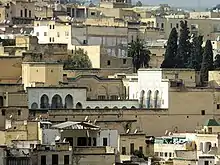Dar Moqri
Dar Moqri (also spelled Dar al-Moqri or Dar Mokri) is a historic palace or aristocratic house in Fes el-Bali, the old medina of Fes, Morocco. It dates from the 19th-20th century, and was built for the wealthy and powerful Moqri family.
.jpg.webp)
History

The Moqri family was a wealthy family of merchant origin which rose to prominence within the royal government as well.[1] In the early 20th century, under the reign of Sultan Abd al-Hafid, the Moqri and Glaoui families became the two most powerful families in the makhzen (royal government) of Morocco. In particular, Muhammad al-Moqri rose to several high offices until he became Grand Vizier. His son, Ahmad el-Moqri, was also appointed governor of Fes.[2] Muhammad was Grand Vizier upon the advent of the French Protectorate in 1912 and kept this post under the formal successors of Abd al-Hafid, throughout the 44-year period of French colonial rule, until right after Moroccan independence in 1956. He died in 1957, at the age of 105.[3][4]:373
.jpg.webp)
The Moqri mansion as it stands may have been completed in the early 20th century[5] but was first established in the late 19th century by Haj Abdeslam al-Moqri, who was in charge of royal constructions under Sultan Moulay Hasan.[6][7][8] It is located in a district historically known as al-'Uyun ("the Sources") and known today as the Ziat or Ziyat neighbourhood, which until the 19th century still had space to build and thus accommodated many new mansions for wealthy families.[1][6][8] (The Glaoui family, for example, also had their mansion in the city here.[1]) Another building, known as the "Riad Driss Moqri", was built further north in the 20th century by Driss Moqri, a brother of Muhammad al-Moqri who was mohtasib in Fes.[9][10]
Architecture
The palace is considered one of the finest examples of late 19th and early 20th century domestic architecture in Fes.[6][8][11] The palace has multiple floors and is built around several inner courtyards, covering around a hectare in total. Its impressive main patio courtyard, surrounded by galleries, is decorated with marble and faience tiles, star-shaped water basins, white marble fountains, zellij tilework, carved stucco, and sculpted wood ceilings.[8][11] Gardens of Andalusian (Moorish) inspiration are also attached.[8][6][9]
References
- Le Tourneau, Roger (1949). Fès avant le protectorat: étude économique et sociale d'une ville de l'occident musulman. Casablanca: Société Marocaine de Librairie et d'Édition.
- Burke, Edmund (2009). Prelude to Protectorate in Morocco: Pre-Colonial Protest and Resistance, 1860-1912. University of Chicago Press. pp. 154–155.
- "Muḥammad al-Muqrī | grand vizier of Morocco". Encyclopedia Britannica. Retrieved 2020-06-06.
- Abun-Nasr, Jamil (1987). A history of the Maghrib in the Islamic period. Cambridge: Cambridge University Press. ISBN 0521337674.
- Aouchar, Amina (2005). Fès, Meknès. Flammarion. pp. 210–211.
- "Palais Abdeslam Moqri" (information sign posted outside the building). Regional Council of Tourism - Fez.
- "Visiting Fez !". www.festourism.org. Retrieved 2020-06-06.
- Métalsi, Mohamed (2003). Fès: La ville essentielle. Paris: ACR Édition Internationale. pp. 155–156. ISBN 978-2867701528.
- "Circuit "Palais et jardin Andalou" à Fès". Vanupied (in French). 2018-06-28. Retrieved 2020-06-06.
- "Palais et Jardins Andalous". Amazingfes (in French). 2014-03-07. Retrieved 2020-06-06.
- Gaudio, Attilio (1982). Fès: Joyau de la civilisation islamique. Paris: Les Presse de l'UNESCO: Nouvelles Éditions Latines. p. 213. ISBN 2723301591.